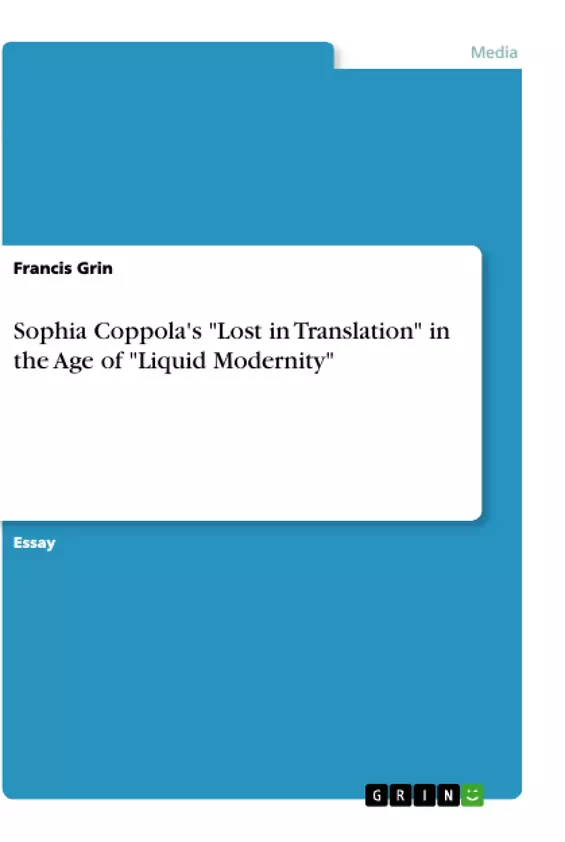In this essay, the author examines the ways in which Sophia Coppola’s film "Lost in Translation" (2003) tackles the discomfort experienced by two strangers living in an age of liquid modernity. This movie becomes a ‘liquid love’ story, in which characters Bob Harris (played by Bill Murray) and Charlotte (played by Scarlett Johansson) meet in at the Hyatt in Tokyo and engage in a somewhat ambiguous “love” affair (ambiguous because it sits between platonic and romantic love). Bob Harris is a worn out movie star who is getting paid two million dollars to endorse a whiskey ad and Charlotte is a recently graduated philosophy student who struggles with existentialist boredom and unemployment. Charlotte and Bob bond throughout their stay in Tokyo through what may be referred to as ‘Mixophobia,’ a term coined by Bauman to describe that which “manifests itself in the drive towards islands of similarity and sameness amidst the sea of variety and difference”. In Tokyo’s “sea of variety and difference” Bob and Charlotte find sanctity in their similarities as they bond over their American backgrounds, their unhappy marriages and their general sense of meaninglessness.
Inhaltsverzeichnis (Table of Contents)
- Introduction
- Lost in Translation: A Liquid Love Story
- Bob and Charlotte: Incomplete Commodities
- Existential Anxiety and the Liquid City
- Liquid Bonds and the Discomfort of Connection
- Conclusion
Zielsetzung und Themenschwerpunkte (Objectives and Key Themes)
This essay explores the themes of liquid modernity and its impact on personal identity and relationships, using Sophia Coppola's film Lost in Translation as a case study. The author examines how the film's protagonists, Bob Harris and Charlotte, experience discomfort and resistance within their liquid environment.
- Liquid Modernity and Its Impact on Identity
- The Discomfort of Liquid Identities
- Existential Anxiety in a Liquid City
- The Frailty of Liquid Bonds
- Resistance to Consumerist Culture
Zusammenfassung der Kapitel (Chapter Summaries)
- Introduction: This chapter introduces the concept of liquid modernity as presented by Zygmunt Bauman and establishes the context for analyzing the film Lost in Translation within this framework.
- Lost in Translation: A Liquid Love Story: This chapter delves into the relationship between Bob Harris and Charlotte, exploring their shared sense of displacement and anxiety within the context of liquid modernity. The chapter explores how their 'liquid love story' unfolds in the context of Tokyo, a city that embodies the characteristics of a liquid city.
- Bob and Charlotte: Incomplete Commodities: This chapter examines how Bob and Charlotte's identities resist the prevailing consumerist culture and the expectations of a liquid identity. Their reluctance to fully embrace consumerism and fashion trends is highlighted, illustrating their incompleteness as commodities.
- Existential Anxiety and the Liquid City: This chapter delves into the existential anxiety experienced by both characters as they navigate the detached and transient nature of Tokyo, a city that represents the liquid city par excellence. Their struggle to find meaning and connection in a world that emphasizes fleeting experiences and superficiality is discussed.
- Liquid Bonds and the Discomfort of Connection: This chapter explores the complexities of relationships in a liquid world, highlighting the tension between the fleeting nature of temporary bonds and the desire for deeper connections. Bob and Charlotte's discomfort with their own relationships and the emergence of new liquid bonds is analyzed.
Schlüsselwörter (Keywords)
This essay centers around the key concepts of liquid modernity, identity, consumerism, existential anxiety, and the liquid city. It draws on the work of Zygmunt Bauman and examines how these concepts manifest in Sophia Coppola's film Lost in Translation.
- Quote paper
- Francis Grin (Author), 2010, Sophia Coppola's "Lost in Translation" in the Age of "Liquid Modernity", Munich, GRIN Verlag, https://www.grin.com/document/1033213



